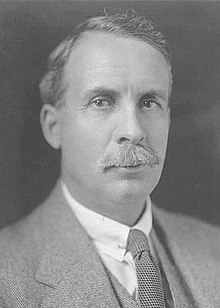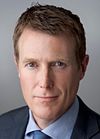Division of Pearce
| Pearce Australian House of Representatives Division | |
|---|---|
 Division of Pearce (green) in Western Australia, as of the 2021 redistribution. | |
| Created | 1989 |
| MP | Christian Porter |
| Party | Liberal |
| Namesake | Sir George Pearce |
| Electors | 119,588 (2019) |
| Area | 13,250 km2 (5,115.9 sq mi) |
| Demographic | Outer Metropolitan |
The Division of Pearce is an Australian electoral division in the state of Western Australia.
A hybrid urban-rural seat located to the east and north of Perth, the division takes in the far northern suburbs of the metropolitan area before fanning inland from the Indian Ocean to take in portions of the Wheatbelt southeast, east and northeast of the capital.
The division includes the Perth suburbs of Mindarie, Ellenbrook and Middle Swan and the 'Avon Arc' Wheatbelt towns of Gingin, Northam, York, Toodyay, Chittering and Beverley.
History[]

The division was named after Sir George Pearce, a founder of the Australian Labor Party in Western Australia, and the longest-serving member of the Australian Senate. The division was proclaimed at the redistribution of 31 March 1989, and was first contested at the 1990 federal election. It has been held by the Liberal Party of Australia for its entire existence, with its first member being the then-deputy Liberal leader Fred Chaney. For most of its first quarter-century, it was usually a reasonably safe Liberal seat.
On 12 June 2012, Western Australian state cabinet minister Christian Porter announced he would contest the federal seat of Pearce during the 2013 federal election due to the retirement of longtime incumbent Judi Moylan. Porter retained the seat for the Liberal Party. In his bid for re-election in 2016, however, Porter suffered a five-point swing, making Pearce a marginal seat for the first time.
In August 2021, the Australian Electoral Commission (AEC) announced that the Wheatbelt Shires of Chittering, Gingin, Northam, Toodyay and York would be transferred from Pearce to the seat of Durack, while the Wheatbelt Shire of Beverley would be transferred to O'Connor. In addition, the Swan suburbs of Aveley, Baskerville, Belhus, Bennett Springs, Brabham, Brigadoon, Dayton, Ellenbrook, Henley Brook, Herne Hill, Millendon, The Vines, Upper Swan and West Swan, along with Pearce's sections of Middle Swan and Red Hill and most of the suburb of Lexia, will all be transferred to the seat of Hasluck. However, Pearce will gain the Wanneroo suburbs of Ashby, Darch, Gnangara, Hocking, Landsdale, Madeley, Pearsall, Sinagra, Tapping, Wangara and Wanneroo, along with the Swan suburbs of Cullacabardee and a small part of Ballajura, from the seat of Cowan. This will transform Pearce into a largely urban seat covering the northeastern and far northern suburbs of Perth, albeit with a large rural area in the eastern part of the electorate. These boundary changes will take place as of the next Australian federal election.[1]
Members[]
| Image | Member | Party | Term | Notes | |
|---|---|---|---|---|---|

|
Fred Chaney (1941–) |
Liberal | 24 March 1990 – 8 February 1993 |
Previously a member of the Senate. Retired | |

|
Judi Moylan (1944–) |
Liberal | 13 March 1993 – 5 August 2013 |
Served as minister under Howard. Retired | |

|
Christian Porter (1970–) |
Liberal | 7 September 2013 – present |
Previously held the Western Australian Legislative Assembly seat of Bateman. Served as minister under Turnbull and Morrison. Incumbent. |
Election results[]
| Party | Candidate | Votes | % | ±% | |
|---|---|---|---|---|---|
| Liberal | Christian Porter | 43,689 | 43.72 | −1.72 | |
| Labor | Kim Travers | 29,027 | 29.05 | −5.20 | |
| Greens | Eugene Marshall | 8,676 | 8.68 | −2.28 | |
| One Nation | Sandy Old | 8,199 | 8.21 | +8.21 | |
| United Australia | Rob Forster | 2,495 | 2.50 | +2.50 | |
| Shooters, Fishers, Farmers | Ross Williamson | 2,125 | 2.13 | +2.13 | |
| Christians | Magdeleen Strauss | 1,609 | 1.61 | +1.61 | |
| Independent | Colin Butland | 1,456 | 1.46 | +1.46 | |
| National | Steve Blyth | 1,342 | 1.34 | −3.35 | |
| Western Australia | Michael Calautti | 1,305 | 1.31 | +1.31 | |
| Total formal votes | 99,923 | 93.03 | −2.42 | ||
| Informal votes | 7,491 | 6.97 | +2.42 | ||
| Turnout | 107,414 | 89.82 | +2.47 | ||
| Two-party-preferred result | |||||
| Liberal | Christian Porter | 57,478 | 57.52 | +3.89 | |
| Labor | Kim Travers | 42,445 | 42.48 | −3.89 | |
| Liberal hold | Swing | +3.89 | |||
References[]
- ^ https://www.aec.gov.au/Electorates/Redistributions/2021/wa/files/redistribution-of-western-australia-into-electoral-divisions-august-2021.pdf
- ^ Pearce, WA, Tally Room 2019, Australian Electoral Commission.
External links[]
- Electoral divisions of Australia
- Constituencies established in 1989
- 1989 establishments in Australia
- Federal politics in Western Australia
